The relative nature of adaptations
In most cases, the observed adaptations are not perfect enough. No adaptation provides 100% survival and does not guarantee 100% success in breeding. For example, a jagged sting of a honey bee, a superficial similarity of protected species during Bets mimicry. In addition, numerous rudiments are preserved - inappropriate structures inherited from ancestral forms (the fifth finger in dogs, the remains of the hind limbs in whales and boas, the third eyelid in monkeys, swimming membranes in mountain geese). Tentatively, it can be argued that up to 90% of species characteristics are not fully adaptive.
In most cases, the observed traits increase the fitness of individuals only under a number of conditions. For example, green coloring is protective only if there is a green background, false-warning coloring of unprotected species during Bets mimicry scares off predators only if there is a protected model, mimetic (imitative) coloring makes the body invisible only if a certain pose is observed. Some adaptations are extremely useful. For example, the structure of the food-grabbing organs of the mantis exactly matches the size of the prey. However, changing the size of the victim can lead to the complete death of the mantis population from starvation.
Adaptation (from the Latin in, the prefix meaning negation and adaptation), non-adaptive specialization, the direction of evolution, in which adaptation to certain conditions of life leads to internal contradictions in the body that impede the further improvement of adaptation. In adaptive evolution was first described by V. O. Kovalevsky (1873) as an example of phylogenetic transformations of limbs of artiodactyl mammals. In the evolution of ungulates in connection with adaptation to fast running on dense soil, a reduction in lateral fingers occurred. In some forms (Anthracotherium, Entelodon, etc.), the reduction of the fingers went faster than the corresponding restructuring of the wrists and tarsal, preserving the primitive structure. As a result, a mechanically fragile limb arose, which, perhaps, was one of the reasons for the extinction of these forms when they competed with those and artiodactyls, evolutionary transformations of the limbs, which were carried out more slowly, but more harmoniously. Adaptation may occur because natural selection favors any change that enhances the fitness of organisms at this stage, but such a change may be ineffective with further evolutionary transformations. The adaptation is traced in the historical development of different groups of animals and plants.
Over adaptation . This term is used in evolutionary biology and refers to the adaptation of an organism with a high voltage of the functions of any organs.
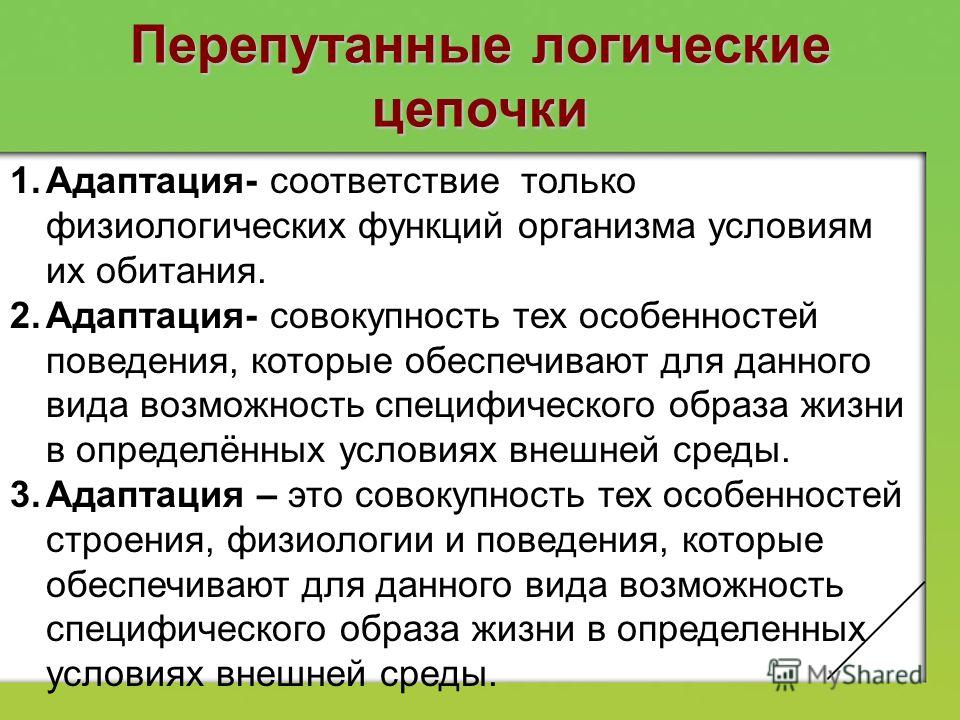
Confused logical chains 1. Adaptation - compliance only of the physiological functions of the body with the conditions of their habitation. 2. Adaptation - a combination of those behavioral features that provide for a given species the possibility of a specific lifestyle in certain environmental conditions. 3. Adaptation is a combination of those structural features, physiology and behavior that provide for this species the possibility of a specific lifestyle in certain environmental conditions.
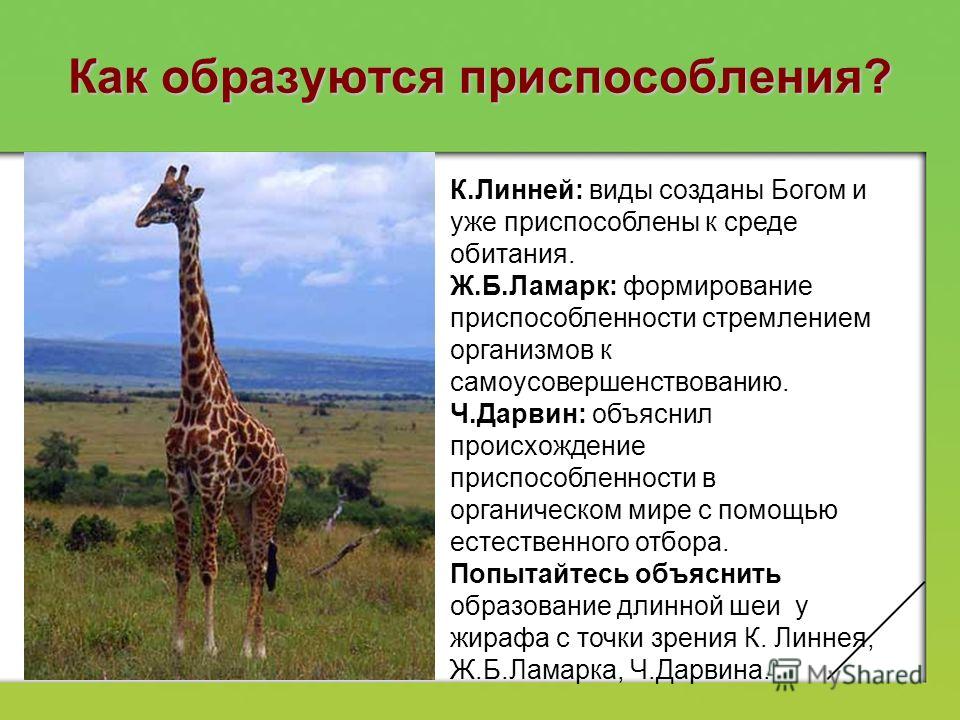
How are fixtures formed? C. Linney: species created by God and are already adapted to the environment. JB Lamarck: the formation of fitness by the desire of organisms for self-improvement. C. Darwin: explained the origin of fitness in the organic world through natural selection. Try to explain the formation of a long neck in a giraffe from the point of view of C. Linnaeus, J.B.B. Lamarck, C. Darwin.

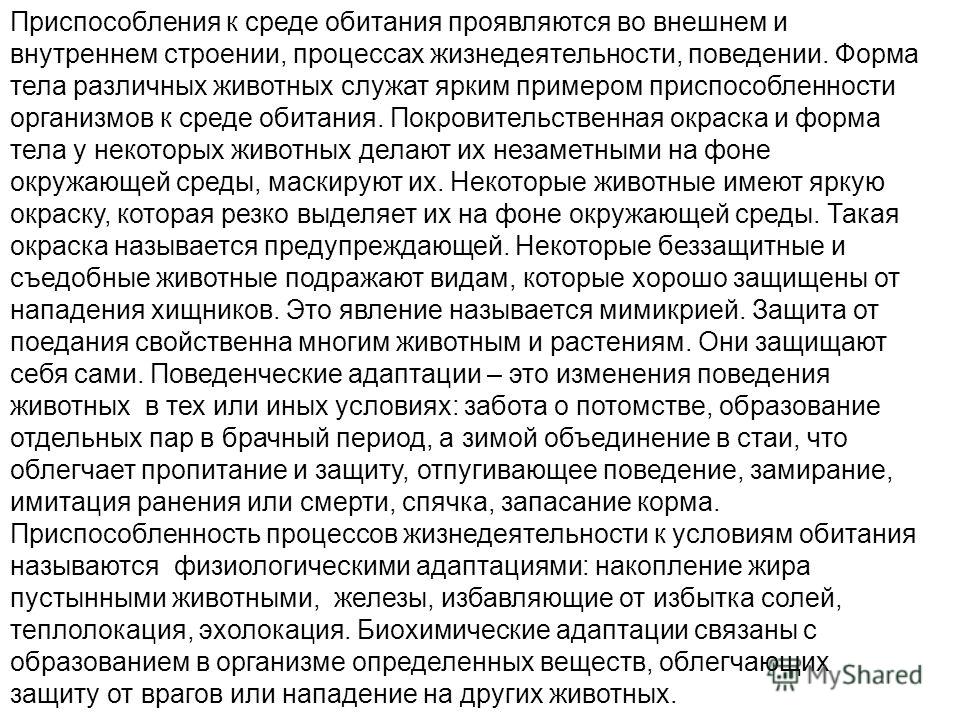
Adaptations to the environment are manifested in the external and internal structure, vital processes, behavior. The body shapes of various animals serve as a striking example of the adaptability of organisms to the environment. The protective color and body shape of some animals make them invisible against the background of the environment, mask them. Some animals have a bright color, which sharply distinguishes them from the environment. This color is called warning. Some defenseless and edible animals mimic species that are well protected from attack by predators. This phenomenon is called mimicry. Protection against eating is common to many animals and plants. They protect themselves. Behavioral adaptations are changes in the behavior of animals in various conditions: caring for offspring, the formation of separate couples during the mating season, and in winter combining in flocks, which facilitates feeding and protection, repelling behavior, fading, imitation of injury or death, hibernation, storing food . The adaptability of life processes to living conditions is called physiological adaptations: fat accumulation by desert animals, glands eliminating excess salts, heat locating, echolocation. Biochemical adaptations are associated with the formation of certain substances in the body that facilitate protection against enemies or attack other animals.

Adaptation formsExamplesDescription of adaptations Advantages Body shape Protective coloring (masking) Warning coloring Mimicry Protection against eating Behavioral adaptations Physiological adaptations Biochemical adaptations Adaptation classification
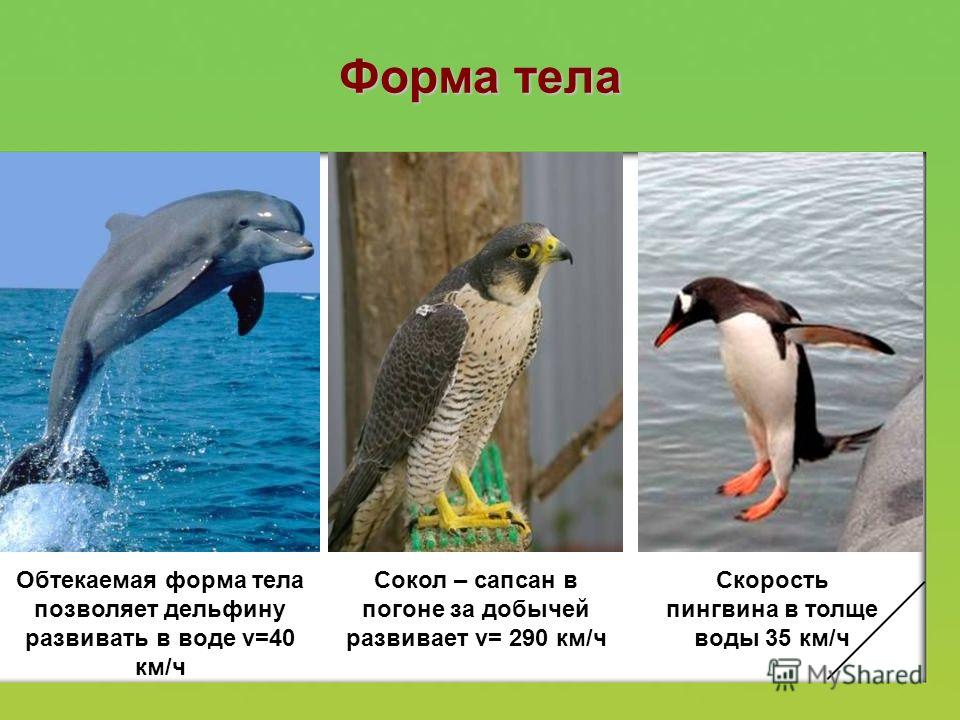
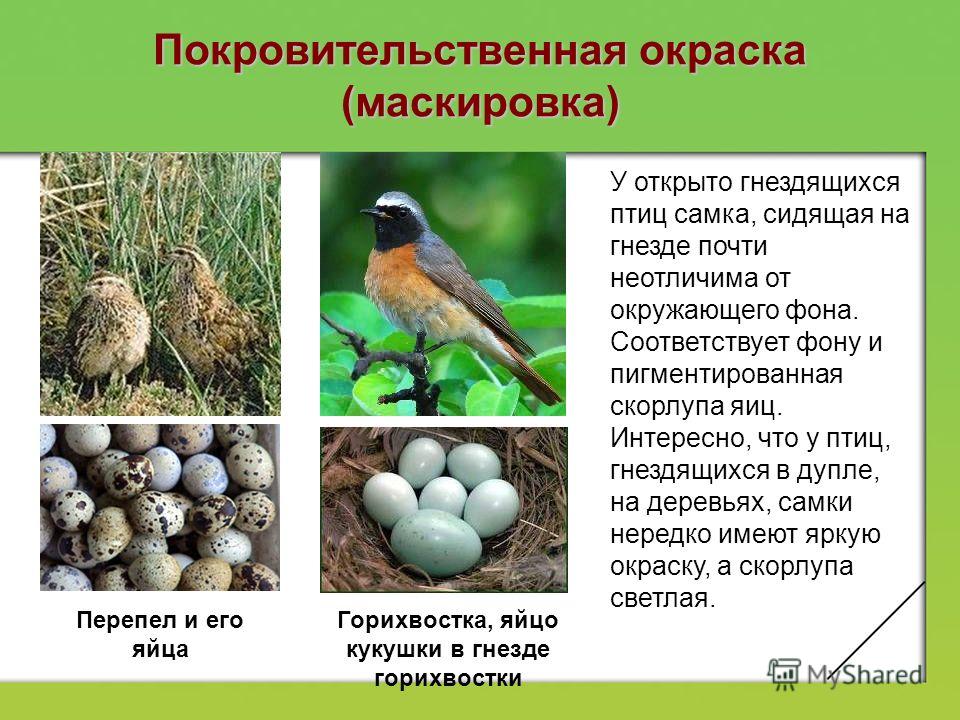
Protective coloring (masking) In openly nesting birds, the female sitting on the nest is almost indistinguishable from the surrounding background. Corresponds to the background and pigmented eggshell. It is interesting that in birds nesting in a hollow, on trees, females often have a bright color, and the shell is light. Quail and its eggs Redstart, cuckoo egg in the redstart nest
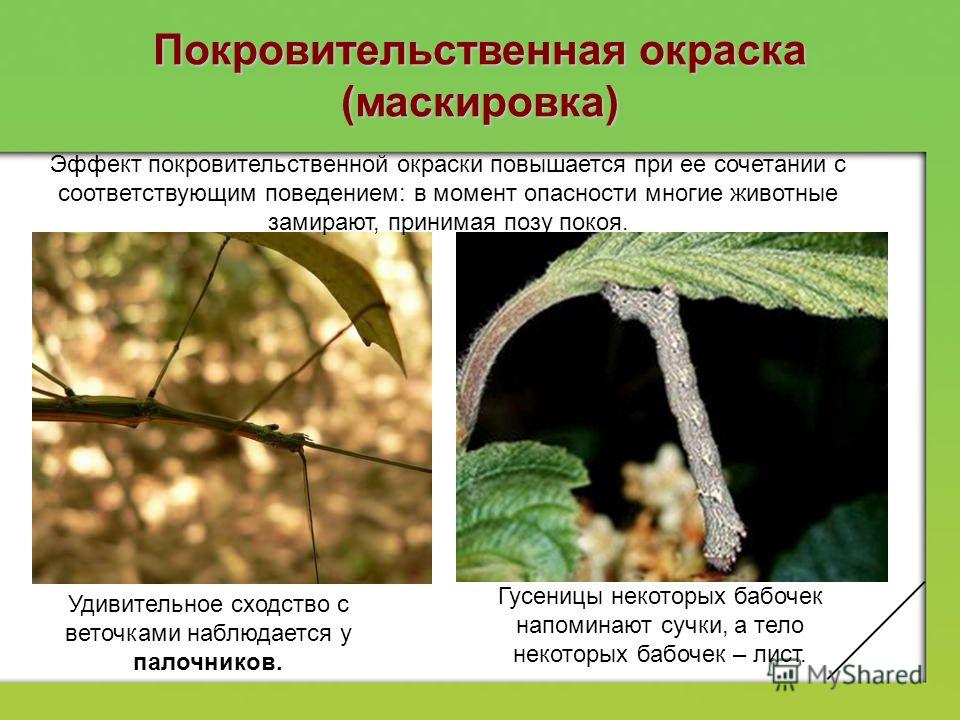
Patronizing coloring (masking) A surprising resemblance to twigs is observed among stick insects. Caterpillars of some butterflies resemble knots, and the body of some butterflies resembles a leaf. The effect of protective color increases when it is combined with appropriate behavior: at the time of danger, many animals freeze, assuming a resting position.
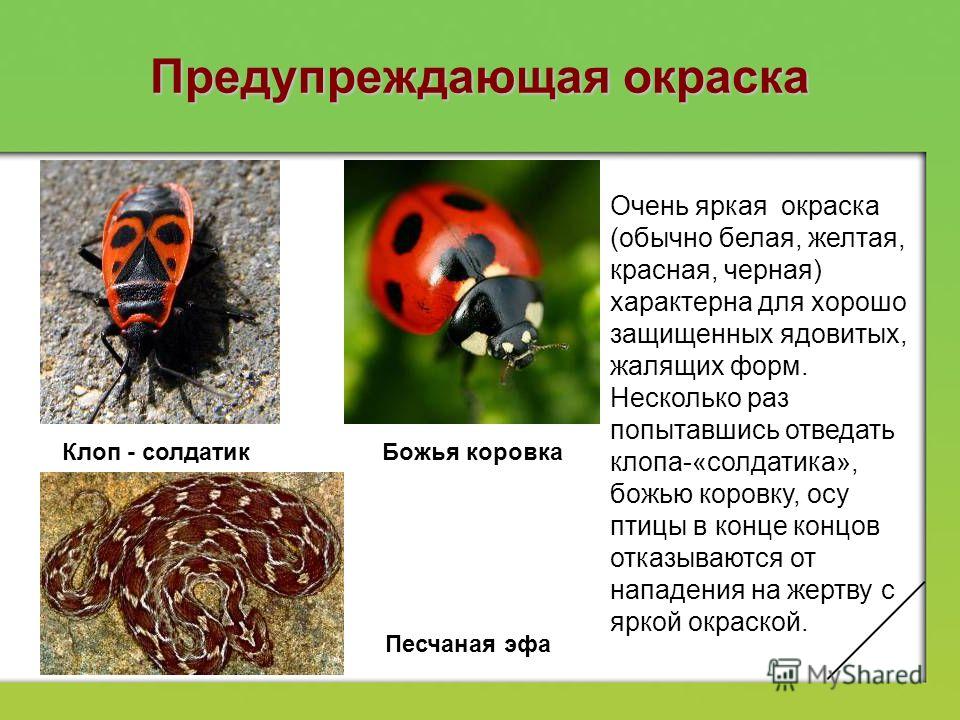
Warning coloration A very bright coloration (usually white, yellow, red, black) is characteristic of well-protected poisonous, stinging forms. Having tried several times to try the “soldier” bug, the ladybug, the wasp, the birds finally refuse to attack the victim with a bright color. Sand Efa Bedbug - Soldier
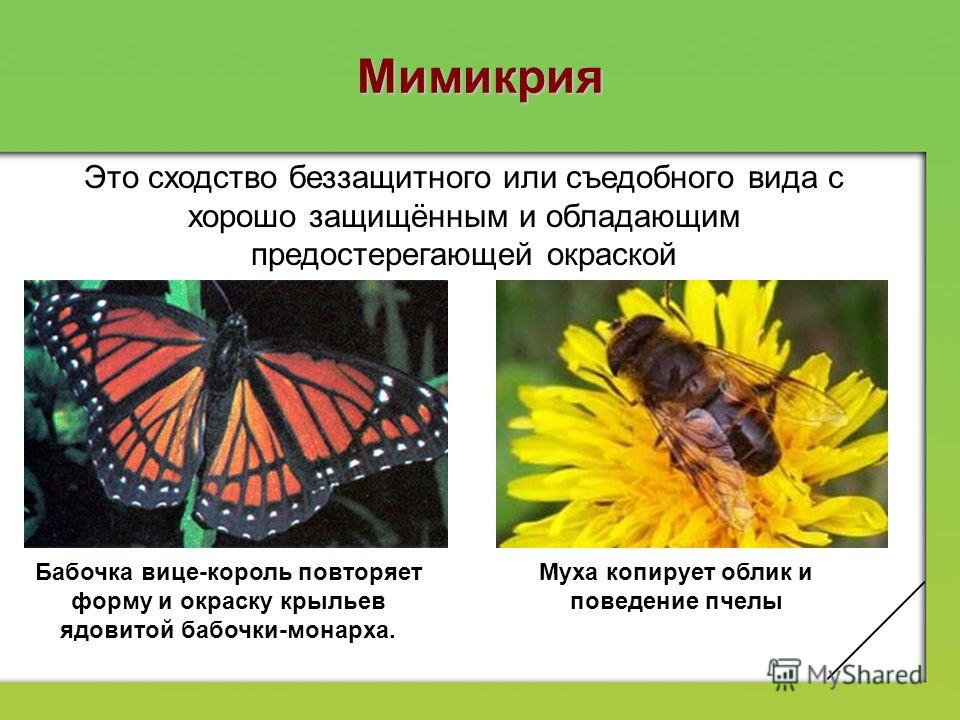
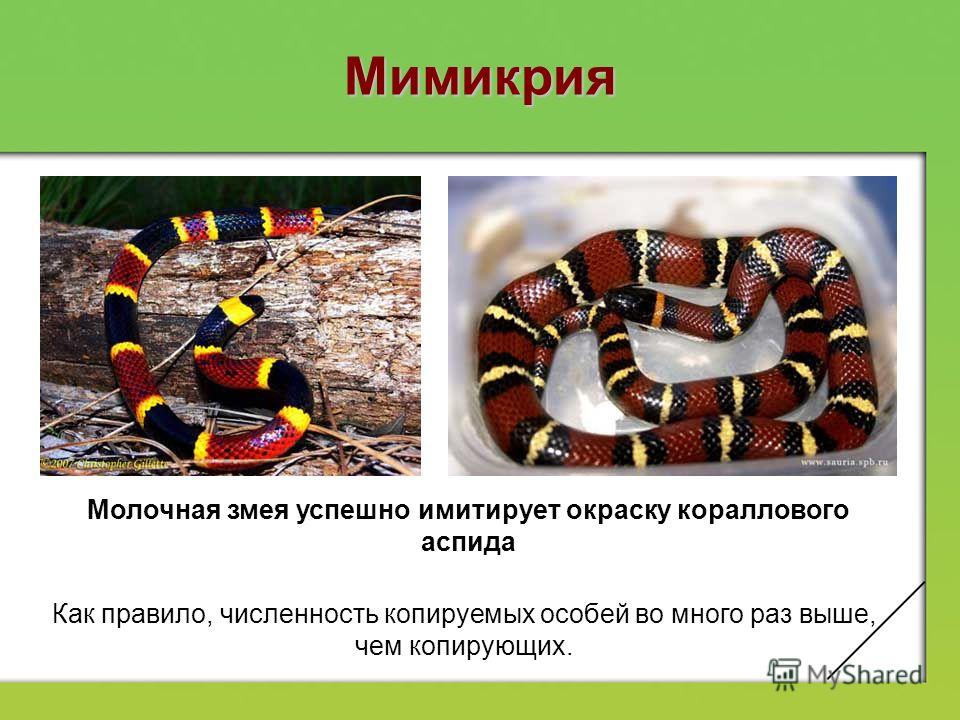

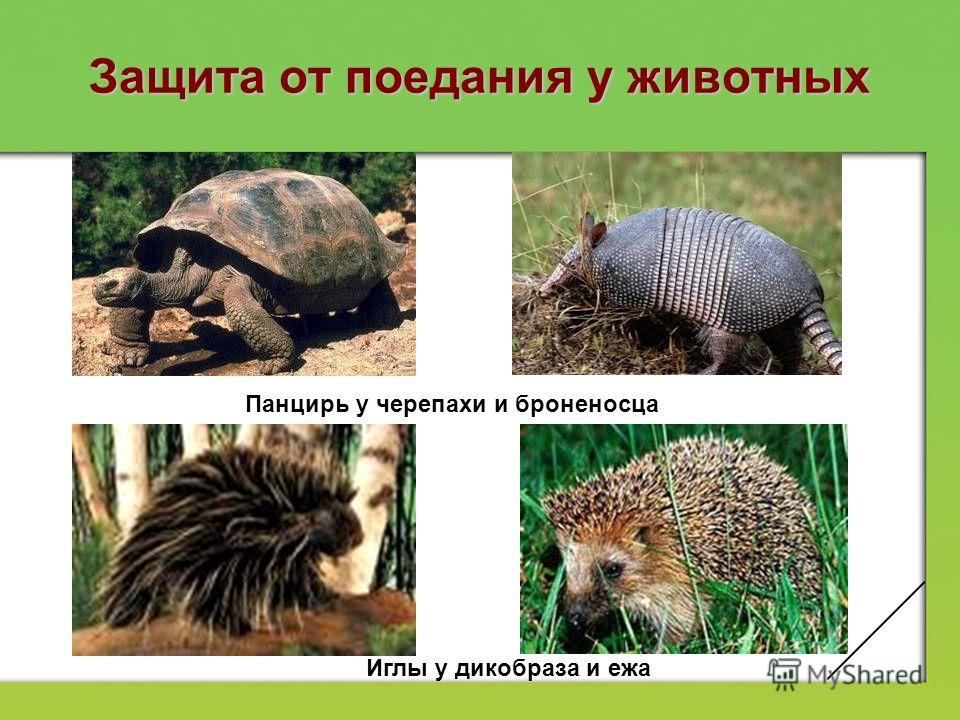
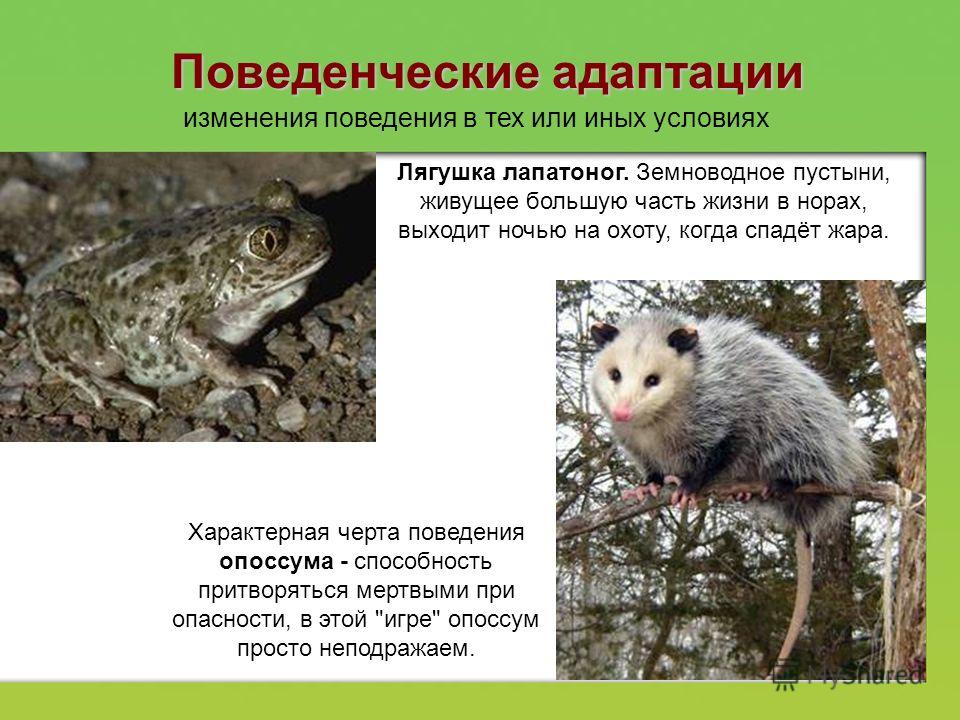
Behavioral adaptations A characteristic feature of the behavior of the possum is the ability to pretend to be dead in danger, in this "game" the possum is simply inimitable. behavioral changes in certain conditions Frog lapatonog. The amphibian desert, living most of its life in burrows, goes hunting at night when the heat subsides.
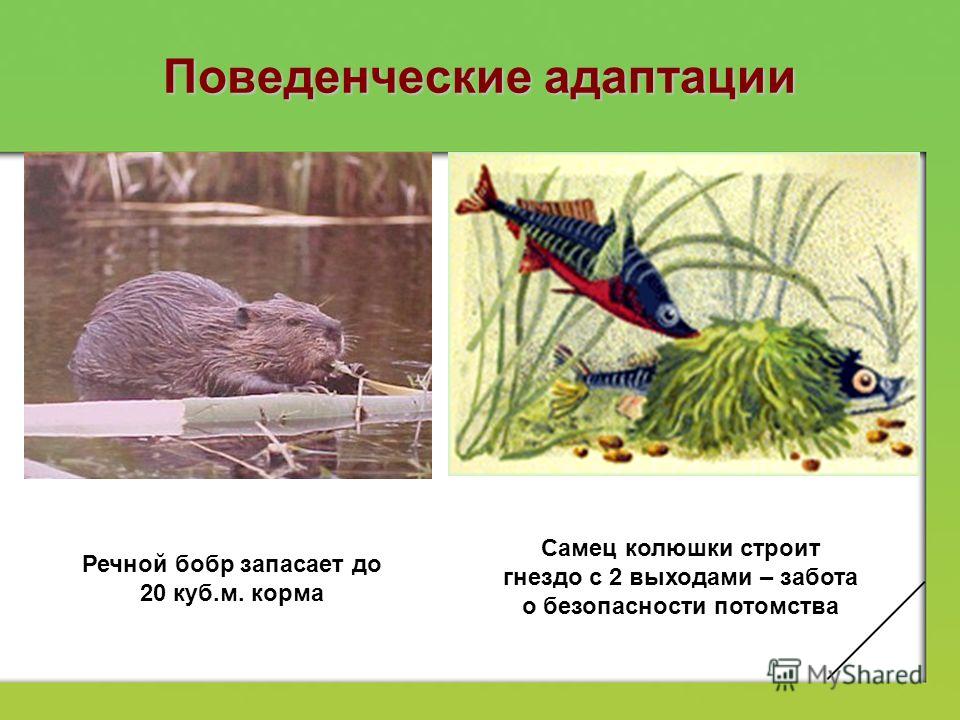
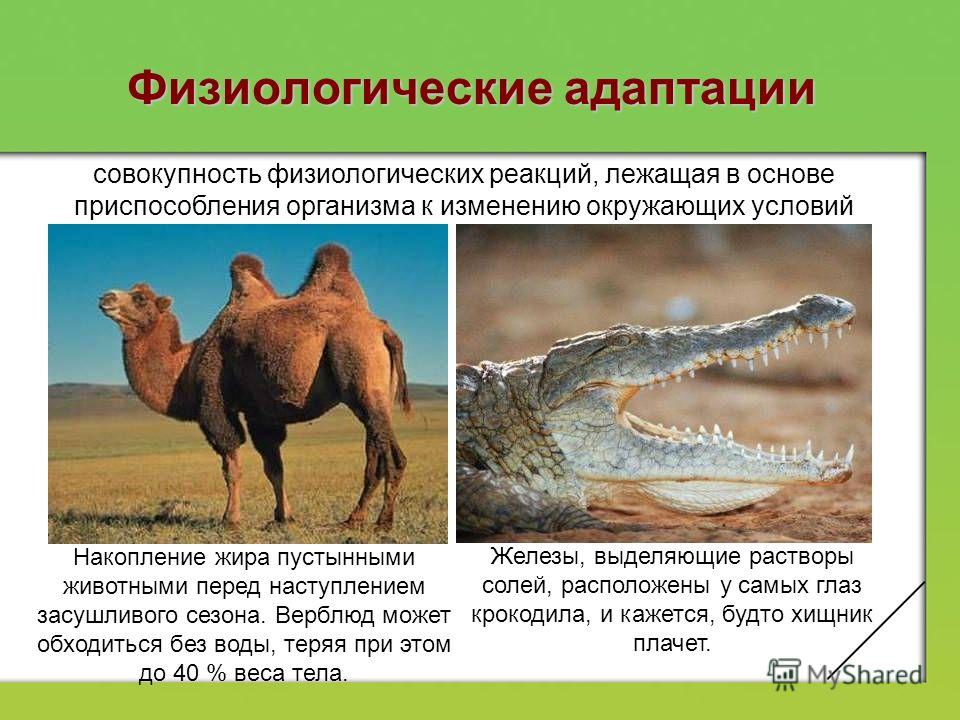
Physiological adaptations are the totality of physiological reactions that underlie the body’s adaptation to changing environmental conditions. Fat accumulation by desert animals before the dry season. A camel can do without water, losing up to 40% of body weight. The glands secreting salt solutions are located at the very eyes of the crocodile, and it seems as if the predator is crying.
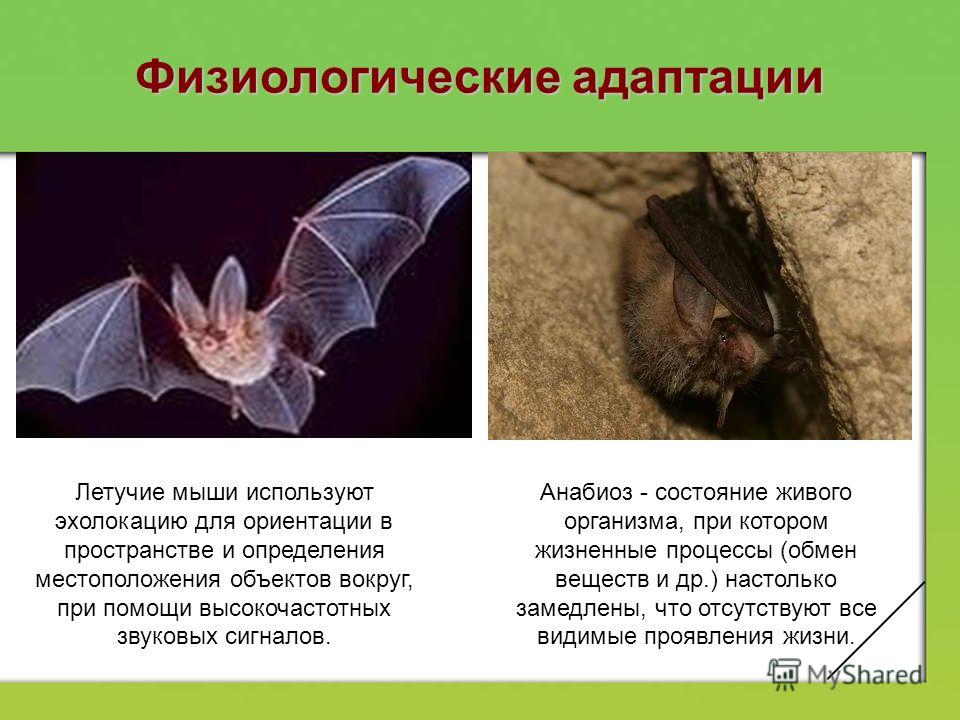
Physiological adaptations Bats use echolocation to orientate in space and locate objects around them using high-frequency sound signals. Anabiosis is a condition of a living organism in which life processes (metabolism, etc.) are so slow that there are no visible manifestations of life.
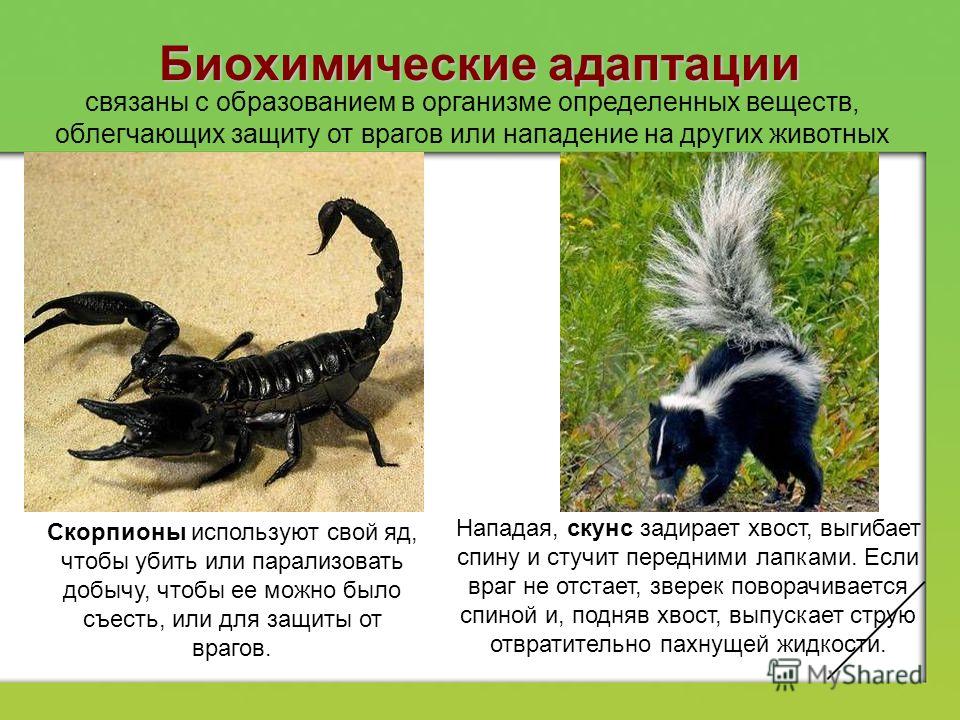
Biochemical adaptations are associated with the formation of certain substances in the body that make it easier to defend against enemies or attack other animals. Scorpions use their poison to kill or paralyze prey so that it can be eaten, or to protect themselves from enemies. When attacking, the skunk lifts its tail, arches its back and bangs its front paws. If the enemy does not lag behind, the animal turns its back and, lifting its tail, releases a stream of disgustingly smelling liquid.
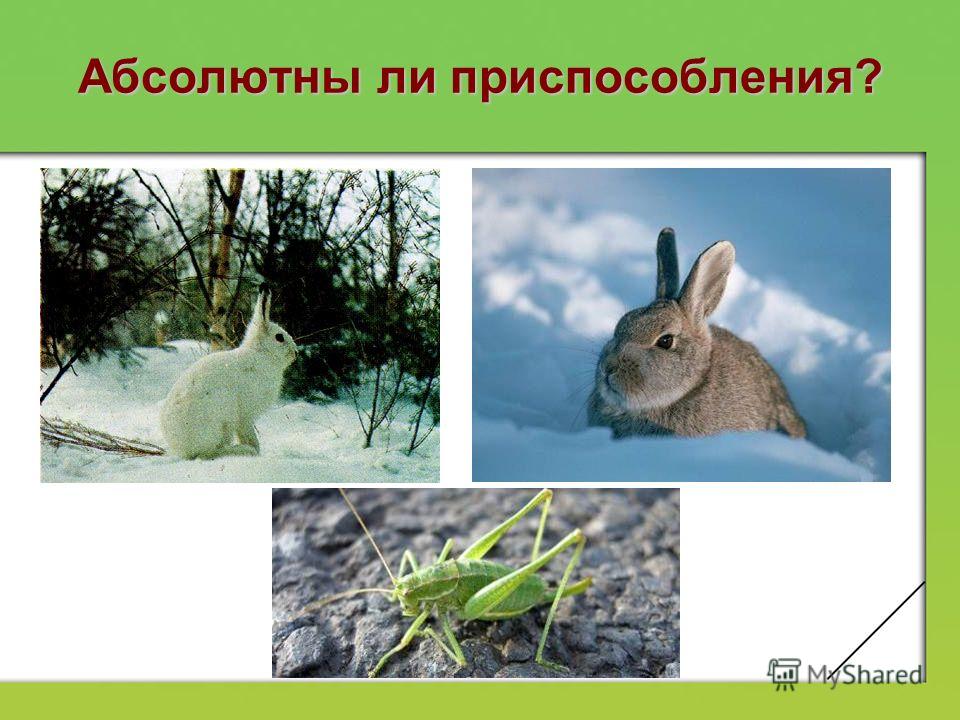
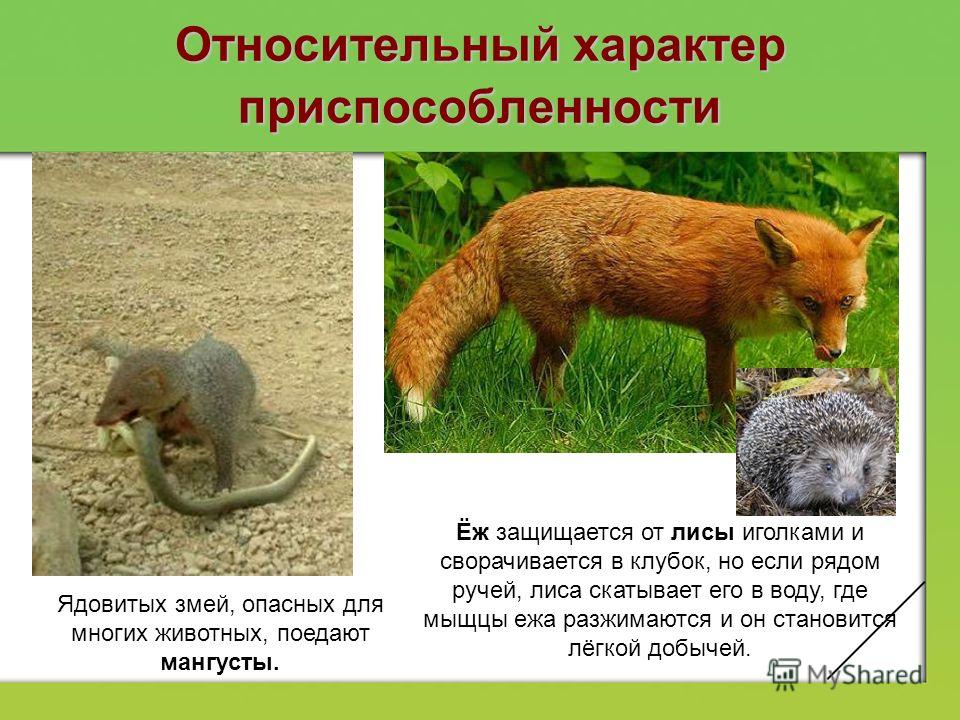
The relative nature of the fitness of poisonous snakes, dangerous for many animals, is eaten by mongooses. The hedgehog is protected from the fox with needles and turns into a ball, but if there is a stream nearby, the fox rolls it into the water, where the hedgehog's muscles are unclenched and it becomes easy prey.
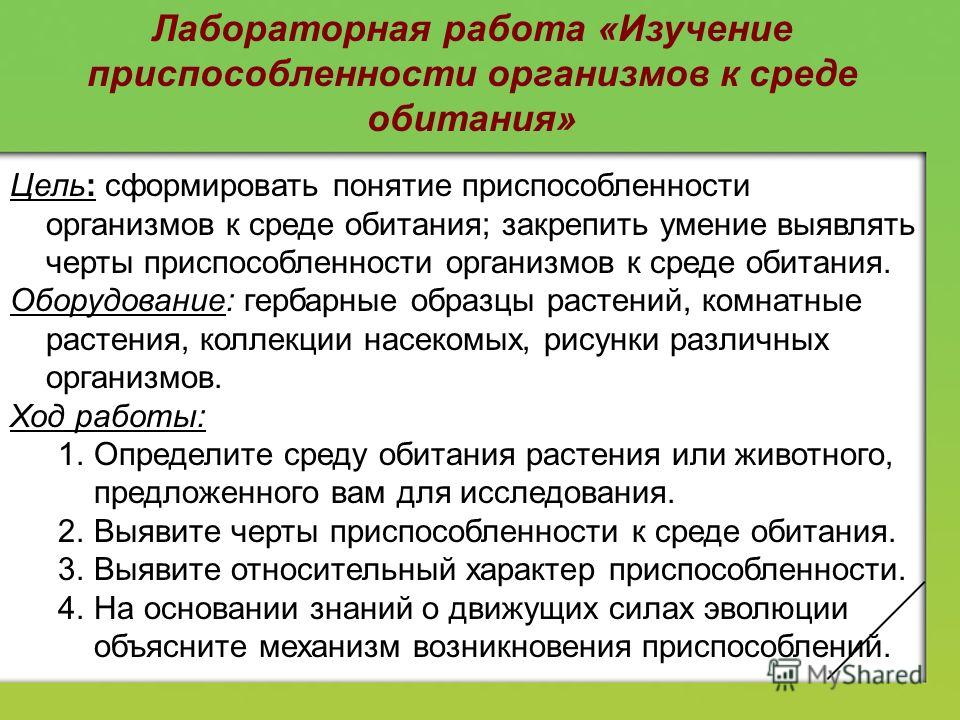
Purpose: to form the concept of adaptability of organisms to the environment; to consolidate the ability to identify features of the adaptability of organisms to the environment. Equipment: herbarium plant samples, indoor plants, insect collections, drawings of various organisms. Progress: 1.Determine the habitat of the plant or animal proposed to you for research. 2. Identify habitat attributes. 3. Identify the relative nature of fitness. 4.Based on knowledge of the driving forces of evolution, explain the mechanism by which adaptations arise. Laboratory work “Study of the adaptability of organisms to the environment”


 29
29


The fitness of organisms is relative, because: 5. The fitness of organisms is relative, because: any adaptation is only appropriate in certain conditions, the struggle for existence can lead to a change in species when the conditions change abruptly, the group dies out 1 2 3

Reflection Which of what you learned in the lesson was familiar to you? What turned out to be new? Which of the things we worked with was the most memorable for you? Why? What did you like in the lesson, what didn’t you like? What would you like to change, to conduct in a different way? Filling 2 columns in the "logbook". 34 Materials used: A.A. Kamensky, E.A. Kriksunov, V.V. Pasechnik "General Biology Class", M., "Bustard",
The Relativity of Adaptation - Section Science of Science, Alekseeva T.I. Ed., Bogatenkov D.V., Drobyshevsky S.V. Anthropology: Educational-methodical complex [Electronic textbook]. - 2004 In Many Human Populations Inhabiting Subtropical And Tropical R ...
Finally, it is known that during postnatal ontogenesis mortality of recessive homozygotes is increased, and, on the contrary, the relative survival of heterozygotes is high (Table 9.1).
Thus, the preservation of the population under conditions of infection with malarial plasmodium is ensured by increased survival of heterozygous individuals. It sounds blasphemous, but maintaining the high frequency of this lethal (!) Mutation is a beneficial adaptive property of the population.
- The fee for such an adaptation is very high, because from the marriage of two heterozygous parents (Hb S Hb A xHb S Hb A) every fourth child is doomed to death:
- Hb S Hb S (SS) definitely die from sickle cell anemia - unfortunately, effective methods of treating the disease have not yet been found;
- Hb A Hb A (AA) runs the risk of dying from malaria;
- and only children HbAHbS (AS) not only survive, but also gain an advantage over the rest. Such children under the law of Mendelian splitting, most likely, will be half of the number of births. They should not be climbers, but in the event of an outbreak of malaria, it is they who have good chances to survive.
Anthropology, ecology, and population genetics are full of similar examples (see: Harrison J. et al. 1979; Spitsyn V.A., 1985; Weiss M., Mann A., 1981).
So, the degree of fitness is a very relative characteristic, always related to a specific situation. Ideal adaptation, as well as adaptively perfect organisms, does not exist.
The result of the process at every moment of time is the maximum approximation of biological characteristics to a certain balanced state with the environment. In fact, this is the process of achieving the optimum in fitness, and the process is continuous due to changes in the environmental situation. The ultimate “goal” of such a process at the population level is the stability of the entire population system, its maximum compliance with these environmental conditions, as well as the ability to further adapt when conditions change. But what is beneficial for the population may not be at all beneficial for its individual representative, and vice versa. An example we just looked at.
9.1.7. If adaptation is relative - how to evaluate it?
If adaptation is such a moving and relative characteristic - how, then, can one measure the degree of fitness, and is it even possible to do this?
Although the questions do not have a simple solution, it is both possible. As criteria for the stability of a human population and characteristics of the adaptation process are used demographic, medical, genetic, physiological, finally, morphological criteria. Of course, assessments of the social order are also applicable (for example, the efficiency of economic activity, cultural features, etc.), which are inextricably linked with human biology. But these phenomena lie outside the scope of our direct study.
So, the degree of fitness of the population can be judged by demographic or paleodemographic indicators. In this case, in fact, it is considered nothing more than a direct characterization of selection. The picture will be more complete if, in parallel with the statement of demographic patterns, it is possible to somehow describe the reasons for the distribution mortality rate.
Another general assessment method is based on approximately this assumption: "since such and such a group of people has been successfully existing in this environment for a long time, it means that it has managed to adapt and develop a set of adaptive traits." In this case, the study is directed, first of all, to the search for geographical patterns of the distribution of human biological properties. But a simple statement that a trait is propagated in accordance with one or another eco-factor is not yet an indicator of its adaptability. Most curious are those signs whose variability may be not just described but explainedenvironmental reasons. It is clear that populations are of particular interest in this regard. indigenous peopleliving in the most extreme ecological regions of the Earth (highlands, arctic, tundra, taiga, desert spaces, etc.).
Since the complexity of the ecological study of man lies in the interweaving of natural and social factors that determine the interaction of man with the environment, at different stages of the work, researchers are forced to artificially isolate its biological or social sides. All we can do is to collect anthropological materials on a larger number of populations, and then try to establish some kind of ecological regularity in their diversity. Only as a result of such painstaking work can we make an assumption about the nature of the adaptation process in each specific of these population groups.
Finally, it is extremely important to remember that although adaptation is always concrete, it is very difficult to describe with the words “good” or “bad”. An organism or an entire population can only be more or less adapted to a particular combination of factors compared with other organisms or groups. That feature that does not look adaptive at the moment can become one in other environmental conditions, and vice versa.
End of work -
This topic belongs to the section:
Alekseeva T.I. Ed., Bogatenkov D.V., Drobyshevsky S.V. Anthropology: Educational-methodical complex [Electronic textbook]. - 2004
Designed for the IDF RUDN Institute for Distant Education of the Peoples' Friendship University of Russia ... ANTHROPOLOGY AUTHORS ... SECTION I INTRODUCTION TO SCIENCE TOPIC ANTHROPOLOGY SCIENCE ON ...
If you need additional material on this topic, or you did not find what you were looking for, we recommend using the search on our database of works:
What we will do with the material received:
If this material turned out to be useful for you, you can save it to your page in social networks:
| Tweet |
All topics in this section:
ANTHROPOLOGY
Group of authors Methodical recommendations Course program Section I. Introduction to anthropology
BOGATENKOV DMITRY VLADIMIROVICH
Bogatenkov Dmitry Vladimirovich - anthropologist, employee of the Institute of Archeology of the Republic of Armenia
DROBYSHEVSKY STANISLAV VLADIMIROVICH
Drobyshevsky Stanislav Vladimirovich - anthropologist, candidate of biological sciences,
ALEKSEEVA TATYANA IVANOVNA
Alekseeva Tatyana Ivanovna - authoritative domestic anthropologist, academician of the Republic of Armenia
THANKS
The authors are sincerely grateful to the reviewers who took upon themselves the work of critical reading of the work — the doctors of biological sciences V.E. Deryabinu (Department of Anthropology, Biological Faculty
Optional materials
The optional materials of the presented educational complex include: annotated textbook articles; Additional materials; brief biographical
Written work
Your research should look solid and strict. To do this, there are established rules for writing work (they may differ in different educational institutions, we are talking about
TOPIC 1. ANTHROPOLOGY - HUMAN SCIENCE
1.1. Lyrical introduction: What do we want? 1.2. Anthropology (history of the term) 1.3. The subject of science 1.4. The Formation of Anthropology in Russia 1.
Anthropology (history of the term)
We rejoice in understanding the truth. If there is no joy, this means that we are only familiar with the truth, but have not been able to comprehend it. R. Tagore To accept (agree) or reject
Subject of science
... with anthropology, natural science is not some kind of island, separated by the abyss from other purely human sciences, so to speak, that is, concerning the highest, the highest
The formation of anthropology in Russia
... the study of a collective person, in all the diversity of its types in space and time ... D.N. Anuchin on the task of anthropology (Anuchin, 1900. P. 33) 1.4
The origins of anthropological research in Russia (XVIII century.)
But the desire to "learn and collect materials", as well as systematize them, arose among the figures of Russian science long before the work of prof. A.P. Bogdanova, and long before the joint ventures were developed
Anthropological works K.M. Bera (first half of the 19th century)
At the beginning of the XIX century. anthropology has not yet taken shape as an independent branch of knowledge. In Russia, the first steps in this direction are connected with the activities of academician K.M. Berah (1792-1876). One of the cr
Self Test Questions
Recommended and quoted
Alekseeva T.I., Efimova S.G. Museum of Anthropology of Moscow State University at the beginning of the second century of its activity // Almanac - 1998. Museums of the Russian Academy of Sciences. M., 1998.S. 289-318. Anuchin D.N.
The contours of science
... just like a microbiologist and histologist are usually represented by a microscope, an entomologist with a butterfly net, a geologist with a Kyle, a symbol of the anthropologist’s work for many
Anthropologists study variability
We noted that the field of view of our science is the diversity of the biological properties of man in time (history) and space (geography). But, strictly speaking, the term "diversity" is not about
Traditional research areas
In general, the introduction of any definition is a very thankless and difficult thing. But an even more formal case is an attempt to divide a single science into separate components (areas and
Objects and levels of research in anthropology
So, the uncertainty of the boundaries between the individual areas of anthropology is largely due to: the interconnection of morphophysiological processes and morphofunctional properties of humans
Human population and population structure
All of these biological definitions are equally true in relation to humans. But anthropology has its own special view. It is associated with a twofold orientation anthropologists
Anthropological sampling
We said that anthropologists are exploring populations. But the vast majority of modern human groups are numerous, and even have a unique intrapopulation structure. Just we bring
Our signs
At the moment, it is difficult to find any body system that has not been examined from an anthropological point of view. I.V. Carriers 2.3.1. Classification of Anthropological
Anthropometric signs
Anthropometric characters are morphological features with a continuous pattern of variation. They include many sizes, one way or another related to the development of musculoskeletal
Soft tissue morphology
In psychological experiments it was established that it is on the person’s face that we pay special attention during identification, communication or remembering. When identifying and communicating, our focus is
Pigmentation
People vary greatly in color of skin, hair, eyes and mucous membranes of the body. In almost all subsequent topics, we will deal with the variability associated with these quality attributes. Differences in
Hairline
Normally, in the process of development in a person three types of hair cover appear sequentially: the primary hair coat (it is also called the germinal coat,
Dermatoglyphic signs
Look at the palm of your hand. You see countless furrows and lines forming intricate patterns. These patterns are unique (individual), and your hand is unique - exactly such a relay
Odontological signs
Odontological features include the entire spectrum of biological properties detected in the human dental system. In domestic anthropology, their research is inextricably linked with the name of A.A.
Discrete epigenetic symptoms
At first glance, very heterogeneous biological properties are combined in this group: some of them relate to the features of bone development (the so-called discretely varying signs of the skull and skeleton), others
Polymorphic Biochemical Systems
We have repeatedly used the term "polymorphism" as a synonym for diversity, that is, giving it the broadest meaning. Sometimes the use of this term does not look very correct
Glossary of Terms
Anthropological form Anthropological characteristic Intra-group variation Sampling Dosto
Self Test Questions
Recommended and quoted
Alekseev V.P. Historical anthropology and ethnogenesis. M., 1989 Alekseev V.P. Osteometry Methodology of anthropological research. M., 1966. Alekseev V.P., Debets G.F. Cranes
TOPIC 3. CONCEPTS OF ANTHROPOGENESIS
3.1. Who are we? 3.2. How can one know the truth? 3.3. Who are our relatives? 3.4. Summary 3.1. Who are we? 3.1.1. H
Taxonomy of primates
According to modern scientific views, man belongs to the class of mammals, the order of primates, the suborder of real monkeys, the hominid family, the genus Man,
Self Test Questions
Recommended and quoted
Alekseev V.P. Person. Evolution and taxonomy (some theoretical questions). M., 1985. Anthropology. An anthology. M., 1997. Rem K.M. The universal law of nature, manifesting
TOPIC 4. ANTHROPOGENESIS - A LOOK IN THE PAST
4.1. Who are our ancestors? 4.2. Monocentrism, dicentrism and polycentrism: how many ancestors do we have? 4.3. Summary 4.1. Who are our ancestors?
Ancestral home
Each researcher adheres to his point of view on which version the evolution of human ancestors was carried out - by means of treasure or anagenesis. Perhaps at different levels
Hominid triad
The framework of the hominid family depends on what traits form the basis for determining the location of specific species in the hominoid system. Since the only modern representative
First people are our ancestors
About 1.6 million years ago, hominins lost almost all the specific features of similarity with pongs and can be called the first real people (Table 4.5). Bi
Self Test Questions
Themes of term papers and essays
The roots of human origin are the missing links. Australopithecus - monkeys or man-apes? Criteria of culture and its beginning. Archanthropes - anthropology and
Recommended and quoted
Alekseev V.P. Person. Evolution and taxonomy (some theoretical questions). M., 1985. Alekseev V.P. Paleoanthropology of the globe and the formation of human races. Paleolithic. M.,
The concept of human race
5.1.1. Human race - what is it? 5.1.2. Racial diversity and the problem of perception 5.1.3. The first schemes (F. Bernier, K. Linney, I. Blumenbach, J. Buffon) 5.1.4
Racial diversity and the problem of perception
Historically, racial studies arose almost earlier than all other areas of anthropology, presenting a peculiar basis for many further successes (and failures) of this science. Differences in appearance
The first schemes (F. Bernier, C. Linnaeus, I. Blumenbach, J. Buffon)
The forerunners of modern scientific racial classifications can be considered the work of the XVII and XVIII centuries. The first known classification of human races was published in 1684 by F. Bernier. He singled out four ra
Mono-and polygenism. Mono-and polycentrism
The study of religion turned out to be an unlucky field of science, since in it, like in no other, are the interests of politics and capital, worldview issues and the fate of many, many people. Spill
Race, Racism, and Social Darwinism
In its extreme expression, polygenism led to racism - recognition of the inequality of different races. Racism bloomed most of all in the middle of the 19th century. in England and America, as well as in France and G
Properties of racial attributes
It is worth recalling briefly about racial attributes, since this issue always generates considerable confusion. Race - the concept of biological and stands out purely and only by biological characteristics
Race, religion, language and type of household
Such social characteristics of groups of people as language, religion, type of economy and others cannot be used in racial studies. There is no causal connection between them and
Race, Ethnicity, People and Nation.
Given the lack of a direct link between biological and social features, it is worthwhile to clearly distinguish between different ways of classifying human groups. Association of people based on a common identity
History of races
The question of the adaptive value of racial attributes is closely related to the question of their antiquity. As far as can be judged by paleoanthropological findings, some racial attributes have already arisen
Autogenetic processes and sexual selection
Isolation and cross-breeding can lead not only to the preservation or mixing of anthropological features. Of great importance are the so-called autogenetic processes. No need for other
Typological concept
A number of anthropologists defined the race as a complex of morphophysiological characters (classic examples of this trend are the schools of K. Pearson, Y. Chekanovsky, the work of A.A. Ivanovsky and others). I agree
Population concept
The population concept has received much greater recognition in racial studies (see the definition of race). According to her, a race is a collection of populations. Attribution of a specific person
Historical concept
Finally, there is another approach - the historical concept of race, put forward by V.V. Bunac. According to her, race is the most historical category. Since the races are in a state of
G.F. system Debec (1958)
A very peculiar scheme of racial relationships, presented by a major domestic anthropologist G.F. Debecom. Probably, it is the most successful among all racial schemes, since
How we will describe the races of the Earth
There are many ways to describe the races of the world. In this case, you can rely on some of the existing schemes or propose a new classification. However, as we have seen, the options for schemes proposed by different
Beginning of the journey - Africa
First of all, it is worth noting that the origin of mankind in Africa does not mean the archaic nature of local populations. A characteristic feature of tropical biota is its rapid evolution,
Continued - Europe and Front Asia
In general, the large Caucasoid race (which is also called the Caucasian, or Eurasian) race is characterized, first of all, by its orthognathic face, which protrudes noticeably forward in a horizontal plane
India, Australia and Oceania
Let's go back south. On the far southeastern borders of the range of the Caucasian race, in India, tropical features in the Indo-European population again begin to intensify (Fig. 5.25). In South India, this see
Continue on - Asia
The Mongoloid (or Asian) race represents the characteristic type of population in most of Asia (Fig. 5.34). Its most typical features are a flattened face with prominent cheekbones,
End of Way - America
Following the changes in the anthropological appearance of people, we have already moved to America (Fig. 5.43). The characteristic features noted in the appearance of the Arctic race are further enhanced by the representative
Self Test Questions
Recommended and quoted
Alekseev I.P. The geography of human races. M., 1974. Alekseev V.P. Historical anthropology. M., 1979. Bunak V.V. Race as a historical concept // Science of Races and Racism.
Ethnic Anthropology
People of the most diverse professions, representatives of different nations want to know their past, want to learn from it, and anthropology, together with ancient history, archeology and ethnography, satisfy
Ethnic anthropology. From biology to history
In the previous topic, we got acquainted with the concept of racial diversity of mankind - intergroup variability in the set (or rather, the complex) of the so-called racial attributes. Having reviewed
Latent danger (about statistics, logic and common sense)
We have just noticed, in fact, the following: the absence of a causal relationship does not lead to the inevitable absence of geographical coincidences that have arisen historically. Following this logic, extremely
6.2.1. Anthropological material: when to use it 6.2.2. General principle of operation 6.2.3. The study of ancient migrations 6.2.4. Indigenous development 6.2.
General principle of work
We noted that the methodological sequence and rigor of research are the positive features that characterize domestic work in the field of ethnic anthropology, starting
The study of ancient migrations
Let’s try to turn upside down any of the examples discussed above, say, the story of Russians settling Siberia in Siberia. Suppose an anthropologist who knows nothing of history,
Indigenous development
Anthropology captures migration. But there is a reverse situation. Sometimes the data of anthropology indicate the invariability and continuity of the population, while in fact there was a laugh
Population structure and endless study perspective
Note that, as a rule, an ethnic group is represented by a group of several populations, and a separate population is very often multi-ethnic, that is, it may include local communities
The origins of research
The study of the anthropological appearance of the Eastern Slavs until the middle of the 20th century. It was irregular. However, already in this period a tremendous amount of material was accumulated, used later in many
Hypotheses, expeditions and new materials
Throughout the twentieth century. there was an accumulation of anthropological materials and a discussion of the results of the study of new groups of the modern and ancient population. An important outcome was the idea of \u200b\u200ba place that
Generalized anthropological portrait of Russians
The Russian population looks quite homogeneous in anthropological terms. Moreover, in just three measuring attributes - by the width of the head, by the width of the nose and the thickness of the lips - Russian groups
Regional anthropological types of Russians
Nevertheless, the nature of the geographical variability of a number of features and their combination made it possible to distinguish among the Russian population several local anthropological options that significantly clarify
Slavs
What did we get: on the one hand, the more or less pronounced homogeneity of the anthropological appearance of the Russians, as a population that fits perfectly into the picture, is undoubted
The origins of the East Slavic peoples
The anthropological literature contains a variety of hypotheses on the origin of Slavic peoples, which can be combined into two groups (see: Alekseeva T.I., 1997): hypotheses
Ancestral home of the Slavs
We just said that we can talk about the significant role of the substrate in the composition of the anthropological composition of the Eastern Slavs at different stages of history. The features inherent in the Balt appear in their appearance
Colonization of East Slavic tribes (Middle Ages)
Judging by the archaeological inventory of Slavic burials, the finds of material culture on the settlements and settlements, "Slavic colonization was of the nature of introducing an advantage
Eastern Slavs in the late Middle Ages
In addition to morphological characteristics, significant data on the composition of the peoples of Eastern Europe are presented by data of historical genogeography. In this regard, the results of the generalized map are curious.
Self Test Questions
Recommended and quoted
Alekseev V.P. The origin of the peoples of Eastern Europe (craniological study). M., 1969. Alekseev V.P. The origin of the peoples of the Caucasus. Craniological study. M., 1974.
Ontogenesis and age-related anthropology
Ontogenesis, or the life cycle, is one of the key biological concepts. This term is already familiar to you - we have repeatedly met with him in the course of discussion. First used it
Fundamental characteristics of the growth process
The process of growth characteristic of a person is called in biology allometric (from the Greek. Allos - different). In contrast to isometric growth (characteristic of a number of multicellular organisms),
Human growth curve (changes in length and body weight)
The process of ontogenetic development can be logically divided into two stages: the period of prenatal development - the prenatal stage, which lasts from the moment the zygote is formed as a result
Growth curves of various tissues and body systems
The growth patterns of most skeletal and muscle parameters approximately repeat the course of the growth curve of the body length. The same can be said about the absolute sizes of individual organs (e.g., liver
Nonlinearity of growth, daily growth and circadian rhythms
So, the vast majority of somatic parameters of the body do not remain constant and change almost continuously. One of the really existing and explained cyclic processes is so on
Growth ordering (canalization, catching up growth and critical periods of development)
Due to the different growth rates of tissues, organs and their systems during embryogenesis, the fetus acquires a structure typical for humans, and in the process of further development, the child turns into an adult
Schemes of ontogenesis periodization
The multifactorial phenomenon, which is the process of human development, is not easy to imagine in the form of a simple scheme. The fact is that with a strict scientific approach, such periodization should simultaneously be
Biological age and developmental factors
7.3.1. Relativity of age. Biological and chronological age 7.3.2. On the criteria of biological age 7.3.3. Tooth age 7.3.4. Dental development
Relativity of age. Biological and chronological age
"How old are you?" - an elementary question with a simple answer: "I was born in YY. Twenty years have passed since then. I am twenty years old." "And how old is Vasya (Pete, Masha ...)? & Q
About biological age criteria
As you may have guessed, one universal criterion of biological age does not exist. A number of maturity criteria work well only at a limited chronological interval.
Tooth age
A person has two generations of teeth (shift or generation), that is, dipiodontism is characteristic, and the dental system is of the heterodont type - the teeth are differentiated by excellent
The development of the dental system and the factors governing this process
How to comment on this information, taking into account the abnormalities of the development of the dental system, as well as remembering how dependent this process is on the balance of nutrition and health
General understanding of skeletal development mechanisms
All those general provisions that we just talked about are directly related to the development of the musculoskeletal system of the body, including its skeletal component. Generally changeable
Determination of skeletal age
Let's return to the biological age we have forgotten. All these features allow us to evaluate it by the bones of the skeleton and skull and consider these estimates to be a good criterion.
Sexual dimorphism and skeletal development
We directly proceeded to the issue of gender differences in the development of the skeleton. Sexual dimorphism in the rate of skeletal development is well fixed by the growth curves of men and women. In general, there are several
A few words about gender genetics
The development of the pelvis and skeleton is "good." But these phenomena are only a consequence of certain deep-seated differences associated with the “gender factor” and manifested during ontogenesis. And how
Peripubertal period and the formation of the reproductive system
The period of puberty, or the period of puberty (from lat. Pubertas - maturation) from the point of view of the scale of biological rearrangements, is one of the most significant stages
Maturity Criteria
The criteria for puberty, developed in auxology and pediatrics, are based on the time of appearance, sequence and degree of development of secondary sexual characteristics, as well as, what is most significant
Mythic Acceleration and Retardation
Captain Nemo's motto perfectly reflects the phenomenon that we are completing with this description. Have you ever thought about why you are so cramped in an old car or airplane, why with so
Some facts
As soon as anthropometry came into practice in examining children in the middle of the 19th century, data on a gradual increase in body length and weight began to accumulate in different countries of the world,
Attempts to Explain
“No one can say for sure what caused this epochal shift” (Harrison J. et al., 1979. S. 427). Having said that, perhaps, further we could have not continued. But all
Self Test Questions
Themes of term papers and essays
Recommended and quoted
Alberts B., Bray D., Lewis J., Raff M., Roberts K., Watson J. Molecular cell biology. In 3 volumes. M., 1994. Alekseev V.P. The formation of mankind. M., 1984. Alec
TOPIC 8. CONSTITUTIONAL DIVERSITY
8.1. The concept of human constitution 8.2. Body Components 8.3. Constitutional schemes 8.4. Functional (physiological) aspects 8.5. Psychologically
The concept of human constitution
The word "constitution" is familiar to everyone. However, in human biology, this term is by no means an inviolable state law. In the previous sections we examined the most
The concept of body components
From the point of view of morphology, any organism can be represented as a “set” of a number of body components that have different values \u200b\u200bfor life activity in different
Methods for determining body components
Determination of body composition can be made by different methods. The simplest and most accurate thing is the classic anatomical definition - working with a corpse. Research of this kind is undoubtedly important for
Age-related variation in body components
In children, the relative development of bone and muscle components is inferior to fat. Fat themselves
Gender differences and variability of body components
Gender differences apply to all three components. In total, they are described by types of andromorphy and gynecomorphy. In men, bone is relatively more developed and we
Constitutional schemes
8.3.1. Construction of the constitution 8.3.2. The basis of everything is the physique coordinates 8.3.3. Schemes of G. Viola and L. Manouvrier (constitution according to body proportions) 8.3.4. Schemes
Constitution construction
There are many (very many!) Constitutions that are good and ... different. The work of a huge number of anthropologists, physicians and psychologists is devoted to the development of constitutional schemes. Among them G. Viola, L. Manouvri
The basis of everything is the physique coordinates
As always in anthropology, separate constitutional schemes are more often developed for men and women. Separate schemes are also offered for children and adolescents. However, this convention is necessary
Schemes of G. Viola and L. Manouvrier (constitution according to the proportions of the body)
Some of these schemes are still used by individual anthropological schools. For example, modifications to the system of the Italian doctor G. Viola are applied by modern Italian and Romanian constitutions
Constitutional schemes V.V. Bunaka (method accuracy)
A similar, but devoid of many of the shortcomings of the previous scheme, is the somatotypological classification developed by V.V. Bunak (Bunak V.V., 1941). Its fundamental difference
Women's Constitution by I.B. Galant
Schemes specifically designed to describe the constitution of women have been developed more than once. The most used of them, perhaps, is the scheme of IB Galant. The author identified three groups of type
Somatotypes of children and adolescents according to VB Shtefko and A.D. Ostrovsky
A separate scientific and practical problem is the definition of constitutional types in children and adolescents. As a rule, the application to children of constitutional schemes designed for adults,
The system of B. Heath and L. Carter (constitution as an open system)
The development of the tradition of W. Sheldon is proposed in the constitutional system of B. Heath and L. Carter. To assess the coordinates of the physique, they proposed using an open scale starting from zero and do not have
Constitution by V.P. Chtetsov, M.I. Utkina and N.Yu. Lutovinova
The most frequently used in the research of domestic anthropologists are the schemes of V.V. Bunaka and I.B. Galant. They differ from most other ease of use and more or less adequate
System B.E. Deryabin (a posteriori approach to describing variability)
So far, we have talked about constitutions, sometimes consisting of a large, but still finite number of discrete types (only Scheldon's scheme and its modifications can be considered exceptions
Biochemical personality
As you can see, there is no shortage of constitutional schemes describing physique. But the concept of the constitution includes not only physique. Her most important
Functional constitution
The presented concept was developed relatively recently. But even without such a powerful theoretical support, many constitutional scientists built their schemes on the basis of not only the external signs of a person, but
A few words about the cyclical nature of biochemical processes
A special property of biochemical characters, in contrast to morphological ones, is significant temporal variability. Morphological characters change over time relatively slowly. Physiologically
Psychological aspects
8.5.1. Is such a connection possible? 8.5.2. Views of E. Kretschmer 8.5.3. The works of W. Sheldon 8.5.4. We discuss a bit 8.5.1. Is possible
The views of E. Kretschmer
More famous, popular and deserve serious discussion of the work of the German psychiatrist E. Kretschmer. Its constitutional scheme has already been given by us earlier (see also: Kretschmer E., 1995
The works of W. Sheldon
Sufficiently rigid relationships of morphology and temperament were described in W. Sheldon. The work was done at a different methodological level and deserves more trust. When describing temperament, the author used
A little reason
So, there are dozens, if not hundreds of studies on the relationship of various mental processes with body types. It was proved, for example, that ectomorphs (they are asthenics, they
Genetic Basics
Since the “norm of reaction" itself is determined by the genotype, the constitution is certainly based on hereditary factors. One extreme point of view on exceptional p
The concept of physical development
The relationship of constitutional features and health is one of the most important aspects of constitutional science. The number of works on this subject is large, although the practical application of
Build and Disease - Talking About Trends Again
Assessment of physical development, of course, is not limited to the three listed indicators. Of great importance are estimates of the level of metabolism, the ratio of active and inactive components of the body,
Glossary of Terms
Andromorphy Biochemical individuality Brachymorphy Vector of variability Gynecomorphy
Self Test Questions
Mandatory
Bunak V.V. Anthropometry. M., 1941. Vasiliev S.V. Fundamentals of age and constitutional anthropology. M., 1996. Human morphology / Ed. B.A. Nikityuk, V.P. Chtetsova
Ecological direction of human science
... the Scythian tribe is significantly different from other people and looks like only itself ... in this country, and animals are found only very few and small. This is because she lies under herself
Anthropoecology studies adaptive variability
The term "ecology" (then gr. Oikos - house or dwelling, logos - study) was introduced in the second half of the XIX century. E. Haeckel. Now, ecology is understood as the science of the relationship of living organisms.
Adaptation
We roughly understood that the interaction in the "organism-environment" system, in fact, is built into a completely consistent scheme: a change in exogenous environmental factors -\u003e adapted
Acclimatization and physiological stress
Acclimatization (from lat. Ad - to, for; Greek. Klima - climate) refers to the process of actively adapting the body to unusual climatic conditions. This is a set of fast hair dryers.
Environmental Variability Trends
9.2.1. Works T.I. Alekseeva: what to read 9.2.2. Geography of some morphological features 9.2.3. Geography of some physiological and biochemical features
Geography of some morphological features
1. The length of the body. The range of geographical variability of body length in the territory of oikumena is significant. According to reports, the difference between the minimum and maximum
Geography of some physiological and biochemical features
1. The main exchange and thermoregulation. Basal metabolic rate (average daily heat production) is an indicator calculated taking into account body length and weight, as well as air temperature
Chemical elements in the environment and in the composition of the human body
Mineral elements are used to build the skeletal system, take part in regulating the osmotic pressure of tissue fluids, and regulate the activity of the cardiovascular and circulatory system
Food
In addition to the mineral component, of course, at least a few words must be said about the role of the general level of nutrition (proteins, fats and carbohydrates) in the geographical variability of human biological characteristics.
Human adaptation in various ecological niches of the Earth
Examples of environmental variability of individual biological characteristics and their complexes can be discussed indefinitely. We don’t need such details now - let’s somehow summarize all this
The main characteristics of adaptive types
So, the adaptive type is the norm of the reaction that independently (converges) arises in similar environmental conditions, in populations that may not be genetically related. According to this
The dynamics of adaptive types and their analogies in the animal world
Judging by the geographical location, adaptive types were formed throughout the history of mankind, and the diversity of populations, apparently, increased significantly with the expansion of
Historical Anthropoecology
On this one could finish the topic, section, and our entire course. But it would be unfair not to say at least a few words about another area of \u200b\u200banthropoecological research, especially
What information do we get
What kind of additional information can we get by examining the paleoanthropological materials, in addition to data on the origin of the population and some information regarding its social
Self Test Questions
Themes of term papers and essays
Recommended and quoted
Alekseev V.P. The formation of mankind. M., 1984. Alekseev V.P. Some aspects of paleoecological research // Materials of the conference "Archeology and Social Progress"
Glossary
A “wolf” tooth is an abnormal development of a tooth that goes away from the usual place of its eruption in the dentition. Associated with impaired teething rates
Questions for self-testing to the topic 1
What does the term “anthropology” mean in the literal translation, by whom it was first used and in what sense? What is a "double understanding of anthropology", on which this
Questions for self-testing to topic 2
What is biological variability? What types of variability can you name (or suggest)? What doctrine can be called the basis of biological anthropology?
Questions for self-testing to topic 3
Why does the question of the origin of man care so much about the minds of people? What is the content of the term "anthropogenesis"? How do religious, philosophical and
Questions for self-testing to topic 4
Give the differences and similarities of primates and humans (biological and non-biological). What "line" separates a person from a monkey? What is a hominid triad?
Questions for self-testing to topic 5
On what grounds can humanity be classified and which of them are racial? How is a race different from an ethnic group? How many races are there in the world? Is it possible to separate
Questions for self-testing to topic 6
What is the subject of study of ethnic anthropology? What is an ethnos? How do the two heterogeneous categories relate - population and ethnicity? What are the relationships between biolo
Questions for self-testing to topic 7
What is ontogenesis? What general patterns characterize the process of ontogenetic development of a person? What is a human growth curve? What is a passport
Questions for self-testing to topic 8
What is a constitution? What are the principles for highlighting constitutional types? What are the characteristics of constitutional types? What constitutional schemes do you
Questions for self-examination to topic 9
What do researchers working in the field of anthropoecology do? What is the difference between adaptation at the genotypic level and fast adaptive phenotypic
Themes of term papers and essays on topic 2
The concept of the variability of anthropological features. Classical and "new" areas of anthropological research. Objects and levels of research in anthropolo
Themes of term papers and essays on topic 4
The emergence of man is the missing link. Australopithecus - monkeys or man-apes? Criteria of culture and its beginning. Archanthropes - anthropology and cult
Themes of term papers and essays on topic 7
The concept of ontogenesis. The main laws of the process of human growth and development and their manifestation. The process of cell differentiation and morphogenesis. Periodization
Themes of term papers and essays on topic 9
Ecological direction of human science: basic theories and concepts. Methods of adaptation and trends of adaptive human variability. Ecosystem and Economic Cool
Read material for topic 5
Dubova N.A. Race: definition and origin of the term Bunak V.V. First racial classifications International “agreements” on the biological aspects of the racial problem
Textbook material for topic 8
Kliorin A.I. The concept of the constitution Kliorin A.I. School of Constitutionology Tanner J. Constitutional system of W. Sheldon Chtetsov VP Scheme V.P. Chtetsova, M.I. Ut
Along with general adaptability, depending on the genotype as a whole and measured by survival and reproduction success, in the process of evolution there are adaptations, or adaptations, for the body to solve the environmental problems presented by the habitat.
Adaptations arise in response to a specific environmental challenge. Because of this, they are always relative. The relativity of adaptation lies in the limitedness of their adaptive value to certain living conditions. Thus, the adaptive value of the pigmentation of butterflies of birch moths in comparison with light forms is evident only on sooty tree trunks. The above example also shows that the degree of adaptability of a trait can only be judged by comparing its two different states.
Adaptation is formed only if there is a type of hereditary information in the gene pool that allows you to change the structure and functions in the required direction.
- Elementary adaptive phenomenon and its transition into adaptation
reaction rates of an individual genotype and the genetic structure of the species as a whole.
The general structure of adaptation is composed of three phases: in adaptive, pre-adaptive, post-adaptive. In each case, these phases can change places.
The adaptive phase. When the environment changes, only a part of the population survives, the rest is eliminated. The facts indicating the inevitability of the passage of an inaptive phase in the evolution of populations were considered above using examples of the development of resistance of microorganisms to antibiotics and insects to poisons. The evolution of large taxa is accompanied by the elimination of an even larger number of individuals. For example, the evolution of the equine family went through the mass extinction of populations.
Pre-adaptive phase. Organisms that survive when environmental conditions change have the necessary prerequisites for this in their organization. The willingness to create new adaptations is especially necessary in the case of rapid and sharp changes in environmental conditions, since adaptation based on the gradual selection of small beneficial mutations is excluded here.
The occurrence of the pre-adaptive phase is determined by genetic factors (mutational and correlative variability) or selection, but in a completely different direction with respect to the future use of the trait (an example with a mollusk shell). But in any case, the transition of the pre-adaptive phase to the usual adaptation is determined by a change in the direction of selection.
Postadaptive phase. The post-adaptive phase is a gradual improvement of an existing adaptation to particular environmental conditions. An excellent example of such an adaptive specialization of a whole complex of characters is shown by a woodpecker. The whole organization of the woodpecker is subordinate to obtaining food during hollowing of tree trunks: the direct beak is firmly connected with the skull, there is a long tongue for catching insects, developed tenacious legs and tail for support on the trunk.
There are several classifications of adaptation. According to the mechanism of action, passive protection devices (high fecundity;
Biological expediency the structure and functions of organisms develops in the process of development of life. She represents historical category. This is evidenced by a change in the types of organizations that occupy a dominant position in the organic world of the planet. Thus, the dominance of amphibians for almost 75 million years was replaced by the domination of reptiles, which lasted 150 million years. During periods of domination of any group, several waves of extinction usually happen. They change the relative species composition of the corresponding large taxon, for example, a class.
The manifestation of adaptation and biological expediency as a whole is explained by the action of natural selection in nature. Of the many random mutations, he saves and accumulates hereditary changes that have adaptive value. This explanation makes it possible to understand why biological expediency, if considered in space and time, is a relative property of living things. It also becomes clear why, in specific living conditions, individual adaptations reach only that degree of development that is sufficient for survival in comparison with the adaptations of competitors.
Finally, it is known that during postnatal ontogenesis mortality of recessive homozygotes is increased, and, on the contrary, the relative survival of heterozygotes is high (Table 9.1).
Thus, the preservation of the population under conditions of infection with malarial plasmodium is ensured by increased survival of heterozygous individuals. It sounds blasphemous, but maintaining the high frequency of this lethal (!) Mutation is a beneficial adaptive property of the population.
- The fee for such an adaptation is very high, because from the marriage of two heterozygous parents (Hb S Hb A xHb S Hb A) every fourth child is doomed to death:
- Hb S Hb S (SS) definitely die from sickle cell anemia - unfortunately, effective methods of treating the disease have not yet been found;
- Hb A Hb A (AA) runs the risk of dying from malaria;
- and only children HbAHbS (AS) not only survive, but also gain an advantage over the rest. Such children under the law of Mendelian splitting, most likely, will be half of the number of births. They should not be climbers, but in the event of an outbreak of malaria, it is they who have good chances to survive.
Anthropology, ecology, and population genetics are full of similar examples (see: Harrison J. et al. 1979; Spitsyn V.A., 1985; Weiss M., Mann A., 1981).
So, the degree of fitness is a very relative characteristic, always related to a specific situation. Ideal adaptation, as well as adaptively perfect organisms, does not exist.
The result of the process at every moment of time is the maximum approximation of biological characteristics to a certain balanced state with the environment. In fact, this is the process of achieving the optimum in fitness, and the process is continuous due to changes in the environmental situation. The ultimate “goal” of such a process at the population level is the stability of the entire population system, its maximum compliance with these environmental conditions, as well as the ability to further adapt when conditions change. But what is beneficial for the population may not be at all beneficial for its individual representative, and vice versa. An example we just looked at.
9.1.7. If adaptation is relative - how to evaluate it?
If adaptation is such a moving and relative characteristic - how, then, can one measure the degree of fitness, and is it even possible to do this?
Although the questions do not have a simple solution, it is both possible. As criteria for the stability of a human population and characteristics of the adaptation process are used demographic, medical, genetic, physiological, finally, morphological criteria. Of course, assessments of the social order are also applicable (for example, the efficiency of economic activity, cultural features, etc.), which are inextricably linked with human biology. But these phenomena lie outside the scope of our direct study.
So, the degree of fitness of the population can be judged by demographic or paleodemographic indicators. In this case, in fact, it is considered nothing more than a direct characterization of selection. The picture will be more complete if, in parallel with the statement of demographic patterns, it is possible to somehow describe the reasons for the distribution mortality rate.
Another general assessment method is based on approximately this assumption: "since such and such a group of people has been successfully existing in this environment for a long time, it means that it has managed to adapt and develop a set of adaptive traits." In this case, the study is directed, first of all, to the search for geographical patterns of the distribution of human biological properties. But a simple statement that a trait is propagated in accordance with one or another eco-factor is not yet an indicator of its adaptability. Most curious are those signs whose variability may be not just described but explainedenvironmental reasons. It is clear that populations are of particular interest in this regard. indigenous peopleliving in the most extreme ecological regions of the Earth (highlands, arctic, tundra, taiga, desert spaces, etc.).
Since the complexity of the ecological study of man lies in the interweaving of natural and social factors that determine the interaction of man with the environment, at different stages of the work, researchers are forced to artificially isolate its biological or social sides. All we can do is to collect anthropological materials on a larger number of populations, and then try to establish some kind of ecological regularity in their diversity. Only as a result of such painstaking work can we make an assumption about the nature of the adaptation process in each specific of these population groups.
Finally, it is extremely important to remember that although adaptation is always concrete, it is very difficult to describe with the words “good” or “bad”. An organism or an entire population can only be more or less adapted to a particular combination of factors compared with other organisms or groups. That feature that does not look adaptive at the moment can become one in other environmental conditions, and vice versa.
